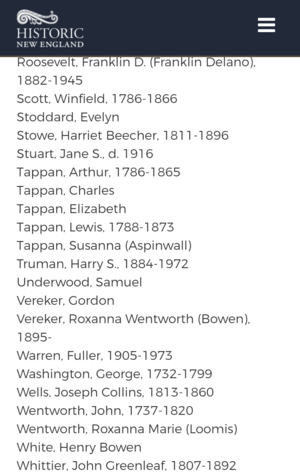Biography
American abolitionist.
Born in Northhampton, Massachusetts, USA on 22 May 1788 to Benjamin Tappan and Sarah Homes. He was the brother of Senator Benjamin Tappan, and abolitionist Lewis Tappan and nephew of Harvard Theologian Rev. Dr. David Tappan.
Arthur married Frances Antill. The marriage took place in Mary Lansing's home. Arthur and Sarah had 8 children. He passed away on 21 Jul 1863 in N Haven.
Born in Northampton, Massachusetts to a devoutly Calvinist family, Tappan moved to Boston at the age of 15. In 1807 he established a dry goods business in Portland, Maine.
In 1826, Arthur and his brother Lewis moved to New York City, a center of business and retail trade, and established a silk importing business. In 1827, the brothers founded the New York Journal of Commerce with Samuel F.B. Morse.
Arthur and Lewis Tappan were successful businessmen, but commerce was never their foremost interest. They viewed making money as less important than saving souls. They made The Journal of Commerce a publication free of “immoral advertisements.” Both men suffered in the Anti-abolitionist riots (1834), in which anti-abolitionist mobs attacked their property. Arthur Tappan was one of two signatories who issued a disclaimer on behalf of the American Anti-Slavery Society in the aftermath of the riots, emphasising its dedication to abolishing slavery within the existing laws of the United States.
The Panic of 1837 forced the Tappans to close their silk-importing business, and almost scuttled their paper, but the brothers persevered. In the 1840s, they founded another lucrative business enterprise when they opened the first commercial credit-rating service, the Mercantile Agency, which became R.G. Dun & Company, the predecessor of Dun and Bradstreet.
The Tappan brothers made their mark in commerce and in abolitionism. Throughout their careers, the Tappans devoted time and money to philanthropic causes as diverse as temperance, the abolition of slavery, and the establishment of theological seminaries and educational institutions, such as Oberlin and Kenyon colleges in Ohio. Their beliefs about observing Sabbath extended to campaigns against providing stagecoach service and mail deliveries on Sundays.
In the early 1830s, while a principal owner of The Journal of Commerce, Arthur Tappan allied with William Lloyd Garrison and co-founded the American Anti-Slavery Society in 1833. Arthur served as its first president until 1840, when he resigned based on his opposition to the society's new support of women's suffrage and feminism. Their early support for Oberlin College, a center of abolitionist activity, included $10,000 to build Tappan Hall. Oberlin's green Tappan Square now occupies the site.
Continuing their support for abolition, Arthur and his brother founded the American and Foreign Anti-Slavery Society in 1840, and the American Missionary Association in 1846. After the Fugitive Slave Law of 1850 was passed, Tappan refused to comply with the new law and donated money to the Underground Railroad. The brothers' positions on the slavery issue were not universally popular. In early July 1834, Lewis Tappan’s New York home was sacked by a mob, who threw his furniture into the street and burned it.
The Tappans and The Journal of Commerce attracted bitter criticism for their campaign to free the Africans who had taken over the slave ship Amistad in 1839. James Gordon Bennett, Sr.’s rival New York Morning Herald denounced “the humbug doctrines of the abolitionists and the miserable fanatics who propagate them,” particularly Lewis Tappan and The Journal of Commerce.
Arthur Tappan died in 1865, Lewis in 1873. Both men lived long enough to see the Emancipation Proclamation grant freedom to millions of African Americans in the South and presage the end of slavery.
Sources
- http://records.ancestry.com/arthur_tappan_records.ashx?pid=30190868
- https://en.wikipedia.org/wiki/Arthur_Tappan
- http://www.fundinguniverse.com/company-histories/the-dun-bradstreet-corporation-history/
- Tappan, Daniel Langdon. Tappan-Toppan Genealogy (D.L. Tappan, Arlington, Mass., 1915) [1]
It may be possible to confirm family relationships with Arthur by comparing test results with other carriers of his Y-chromosome or his mother's mitochondrial DNA. However, there are no known yDNA or mtDNA test-takers in his direct paternal or maternal line. It is likely that these autosomal DNA test-takers will share some percentage of DNA with Arthur:
-
~1.56%
Leda Behseresht
 :
AncestryDNA, GEDmatch A089284 [compare], Ancestry member ledabeh
:
AncestryDNA, GEDmatch A089284 [compare], Ancestry member ledabeh
-
~1.56%
 ~3.12%
Laura Emerson
~3.12%
Laura Emerson  :
AncestryDNA, Ancestry member led48
:
AncestryDNA, Ancestry member led48
-
~0.78%
Theodora Ashmead
 :
23andMe
:
23andMe
Have you taken a DNA test? If so, login to add it. If not, see our friends at Ancestry DNA.
 Priscilla Savary
Priscilla Savary
Featured National Park champion connections: Arthur is 7 degrees from Theodore Roosevelt, 17 degrees from Stephanus Johannes Paulus Kruger, 9 degrees from George Catlin, 11 degrees from Marjory Douglas, 22 degrees from Sueko Embrey, 11 degrees from George Grinnell, 21 degrees from Anton Kröller, 12 degrees from Stephen Mather, 19 degrees from Kara McKean, 15 degrees from John Muir, 12 degrees from Victoria Hanover and 24 degrees from Charles Young on our single family tree. Login to find your connection.


